Trees are essential to life. They absorb carbon dioxide and then release the oxygen that we breathe. Their roots prevent life-altering, if not fatal, soil erosion and landslides. Many communities, including over half of United States residents, receive their drinking water from forested watersheds. Trees give life, in a very literal sense. But a handful of trees can be life-takers rather than life-givers. It’s important to recognize these trees and their potential dangers. Here are five of the most dangerous trees currently found in the United States.
Manchineel Tree (Hippomane mancinella)
The most dangerous tree in the world grows in the United States. That sounds like hyperbole, but it’s actually quite true.
In 2011, the Guinness Book of World Records declared the manchineel tree to be the world’s most dangerous tree. The tree is native to parts of Central America, South America, and the Caribbean islands. It is also native to the United States territories of Puerto Rico and the Virgin Islands, as well as the state of Florida. You read that correctly. Florida is the native habitat of the world’s deadliest tree.

The world’s most dangerous tree doesn’t look that dangerous at all, does it?
©iStock.com/shakzu
Now, before Floridians decide they will never set foot outside again, it should be noted that the likelihood of encountering this tree is relatively low. But a low likelihood doesn’t mean it’s impossible.
The trees are mostly found in the wilds of the Everglades and the Florida Keys. When hiking in these areas, it’s important to watch for possible manchineel trees. In state and national parks, rangers and park service employees do a stellar job of keeping the trees away from marked trails, but it’s still important to keep an eye out. And it is imperative that hikers stay on dedicated trails. Going off-trail exponentially increases your chances of coming in contact with a manchineel tree.
What’s The Big Deal About This Tree?
The manchineel tree is part of the large Euphorbia genus. The poinsettia, a common holiday floral decoration, is also in this genus.
The manchineel tree produces a thick, milky sap that causes severe blisters if it touches human skin. The sap oozes from all parts of the tree. It is found on the bark, the leaves, and even on the fruit.
This sap contains a potentially lethal cocktail of toxins, the most dangerous of which is phorbol. Phorbol is a highly water-soluble organic compound, which means it’s even dangerous to stand under this tree in a rainstorm. The raindrops that drip from the tree will contain diluted toxic sap which can still severely blister human skin.
The sweet-smelling fruit from the tree looks like small apples, so much so that they are commonly referred to as “beach apples.” That’s an unfortunate nickname, though, because it can lead an uninformed passerby to sample the fruit. The fruit from the manchineel tree is highly toxic.
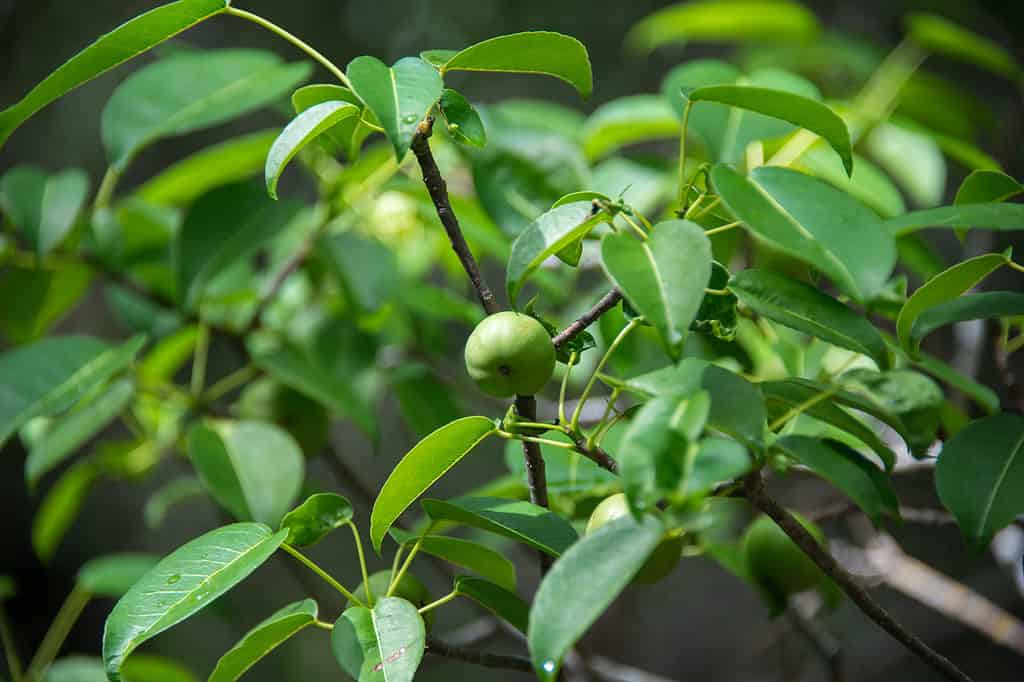
The small apple-like fruit of the manchineel tree can be lethal.
©Karuna Eberl/Shutterstock.com
The manchineel’s fragrant fruit has a deceptively sweet taste, but it is laced with phorbol. The first symptoms of poisoning manifest within minutes of ingesting the fruit. Consuming this toxic fruit can lead to internal bleeding, edema, shock, and, quite often, death.
Identifying the Manchineel Tree
Ironically, this tree that is known in Spanish as árbol de la muerte (which translates as “tree of death”) has quite a lovely appearance. The tree can grow upwards of 40 feet tall, with reddish-gray furrowed bark.
The tree features glossy, oval-shaped leaves that grow in an alternating pattern. Tiny yellow flowers grow from spikes on the ends of the branches. The small sweet-smelling fruits are green or yellow, sometimes with an orangish-red tinge. These single or paired fruits only grow to about two inches in diameter, but don’t let their diminutive size fool you. They are lethal.
Historic Encounters with Manchineel Trees
The manchineel tree has a long history that has led to its infamous reputation as the world’s most dangerous tree.
When Christopher Columbus’ crew landed in the Virgin Islands in 1493, a tree growing near the beach immediately caught their eye. The fruit of this tree looked and smelled quite appealing to these famished seafarers, so they picked some and began to eat. That was definitely a mistake.
Spanish explorer and conquistador, Juan Ponce de León, died after being shot by an arrow in a battle with the Calusa Native American people in Florida. The arrow was reportedly tipped with the toxin of the manchineel tree.

All parts of the manchineel tree are toxic, including the bark, sap, leaves, and fruit.
©iStock.com/NajaShots
The history of this deadly tree goes on and on. There are reports of sailors who cut the tree as firewood, only to end up blind from the toxins. Shipwreck victims who were starving and ate the manchineel fruit, with disastrous consequences. There are even records of people who were captured and tortured by being tied to a manchineel during a storm, so the poisoned raindrops burned their skin. This torturous act was portrayed in the 1956, movie, “Wind Across The Everglades,” where a poacher named Cottonmouth (played by Burl Ives) tied a victim to a manchineel tree to be tortured to death by the milky sap.
This tree has a dark history, indeed.
Just Get Rid of Them?
With this much evidence about the many harms inflicted by manchineel trees, wouldn’t it be better to simply rid the planet of them altogether? Actually, no.
While the trees are harmful, even potentially lethal to humans and many animals, they do serve an important ecological purpose. The trees normally grow on the beach or in swamps, where they can reduce erosion and serve as windbreaks. This helps the entire ecosystem.
Sandbox Tree (Hura crepitans)
As if the manchineel tree wasn’t enough, Florida is home to a second tree that is counted among the world’s most dangerous. This tree is endemic to Puerto Rico and the Virgin Islands, as well. The rest of its native range includes tropical regions of North America and South America, including the Amazon rainforest.
The sandbox tree (also known as possumwood or jabillo) can normally grow 100-130 feet tall, although some have been documented at nearly 200 feet tall. The tree displays simple, broad leaves and red flowers. The most recognizable feature of the tree, though, is its gray bark that is covered in large, conical spikes. These spikes have earned the tree its colloquial nickname, monkey-no-climb.
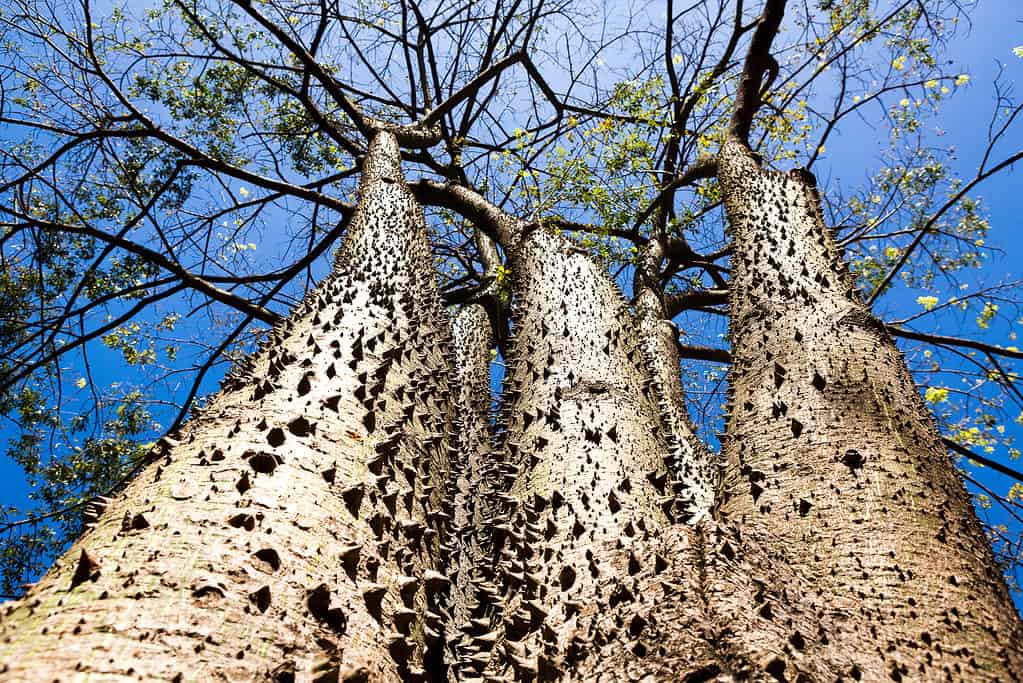
The sandbox tree has large spikes all the way up its trunk.
©iStock.com/William Rodrigues dos Santos
But the foreboding spikes are just the beginning of the dangers embodied in this tree. The tree oozes toxic sap. A person or animal that comes in contact with this sap will develop an extremely painful rash and aggressively blistering red welts on the skin. If the sap contacts the eye, it can cause blindness. Indigenous peoples would use this sap to poison arrows and darts to be used in hunting as well as in warfare.
This is certainly enough reason to steer clear of the sandbox tree, but we haven’t even covered the most dangerous aspect of this tree yet.
Exploding Fruit (Yes, We’re Serious!)
Sandbox tree fruit looks somewhat like little pumpkins. Once the fruit dries into seed capsules, they become ticking time bombs. When they are fully mature, they explode with no warning. The explosion sounds like a gunshot and it sends the hardened seeds flying at over 150 miles per hour!
It’s known as explosive dehiscence. It is a ballistic form of seed dispersal. In this way, the plant does not need to rely on animals to spread its seed.
There is an obvious downside, though. Any human or animal that is in the area at the moment of explosive dehiscence can be injured, or even killed, by these bullet-like projectile seeds.
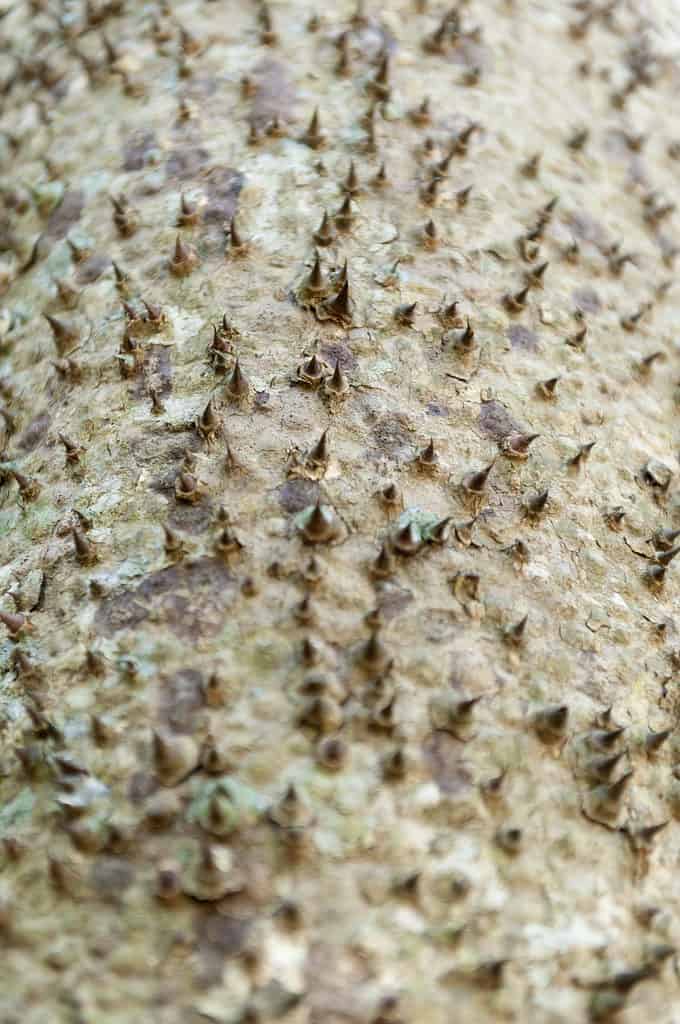
Don’t mess with the sandbox tree!
©iStock.com/Westhoff
Poison sap. A spiked trunk. Fruit that explodes. For a tree with such a childlike name, the sandbox tree is not one to trifle with.
Other Dangerous U.S. Trees
After detailing the potential horrors of the manchineel and sandbox trees, the dangers posed by other U.S. trees may seem to be bush league (botanical pun most definitely intended). But other U.S. trees do present dangers, and they are much more common than the manchineel and sandbox trees.
Eastern Cottonwood (Populus deltoides)
No, cottonwood trees are not poisonous like the manchineel or sandbox trees, but they do present a different, and less sensational, type of danger.
Over half of U.S. states are within Eastern Cottonwood’s native range. In the United States, the tree is endemic through all of the midwest, much of the Deep South, and as far north as Vermont in the east and Montana in the west.
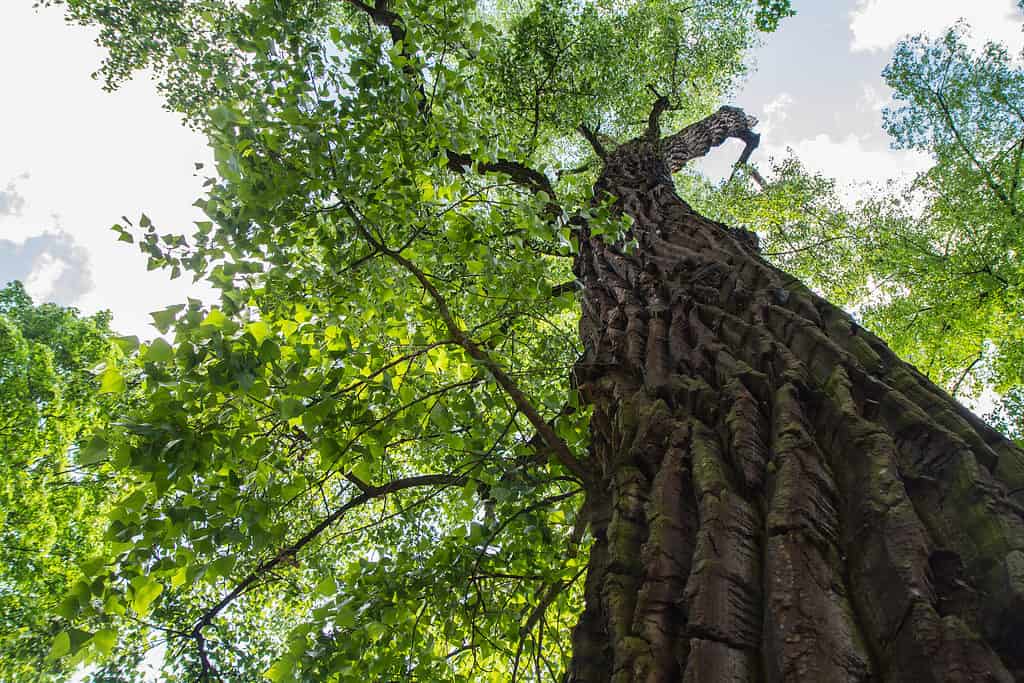
The Eastern cottonwood tree grows to towering heights.
©iStock.com/teine
The Eastern cottonwood tree is typically found near streams and along riverbanks. It’s not uncommon to find pure stands of Eastern cottonwoods. It is one of the largest of the eastern hardwoods, reaching heights of 70-100 feet. It also grows with remarkable speed. If it receives enough moisture, the Eastern cottonwood can grow up to eight feet a year. Therein lies its hidden danger.
Tall Tree, Shallow Roots
This tree reaches impressive heights quickly, but it doesn’t grow a deep root system at the same speed. A tall tree with shallow roots can become quite top-heavy, making it a dangerous fall risk. The wood is also relatively weak. This makes the Eastern cottonwood tree a particular danger in adverse weather conditions.
The tree normally grows in very wet environments. A strong wind can uproot the tree from the saturated ground, bringing the whole tree down. Branches, and sometimes entire trees, can also come down during ice storms. This poses a danger to both people and property if an Eastern cottonwood tree is growing in a populated area. This is certainly not a tree that is suitable for residential or urban landscaping.

Shallow roots and brittle wood make Eastern cottonwood a significant fall risk.
©iStock.com/Robert Gergely
Eastern cottonwoods are mainly grown for pulpwood, shipping crates, plywood core stock, and lightweight furniture today.
They are also ecologically important as young Eastern cottonwoods provide food for white-tail deer, rabbits, and other woodland animals. Beavers use young Eastern cottonwoods for food and to construct dams. Countless species of birds nest in Eastern cottonwoods. The tree is also valuable because the Eastern cottonwood naturally grows in floodplains, where many other trees cannot.
Black Locust Tree (Robinia pseudoacacia)
The native range of the black locust tree extends from Pennsylvania through the Appalachians and into northern Georgia. It extends westward to Arkansas and Oklahoma. However, it has been introduced all over the nation. There are documented black locust trees growing in all 48 of the contiguous U.S. states.
While it can grow practically anywhere, the black locust proliferates on roadsides, in fencerows, on farmland, and in other areas where the soil has been disturbed.
The bark of the black locust is deeply furrowed and features large thorns that extend to the branches. Brown seed pods are found on the tree during the winter, measuring 2-4 inches long. The tree blooms in spring or early summer, displaying drooping clusters of white flowers that are 4-8 inches long.
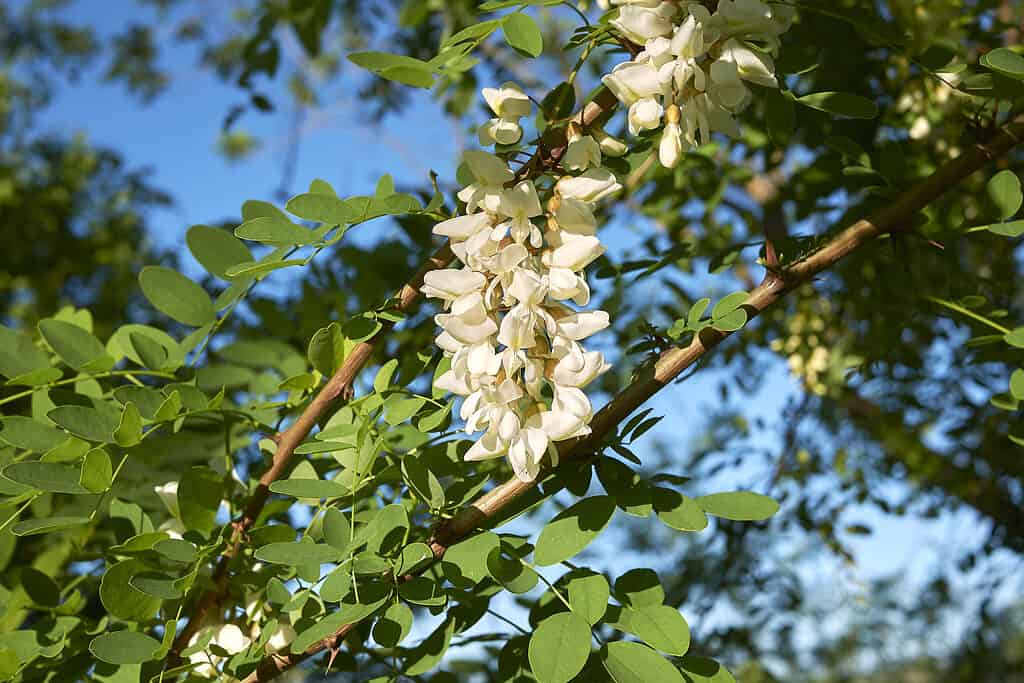
The black locust tree blooms with clusters of white flowers.
©iStock.com/seven75
The tree is a magnet for bees and other pollinators. In fact, the honey that is made from black locusts is highly prized. However, due to its rapid proliferation, the black locust is considered an invasive species in certain areas.
The Danger of the Black Locust Tree
The large thorns on the tree serve as a warning to stay away. But if that warning is ignored, this tree packs an additional punch.
Black locust trees contain robin and phasin toxalbumins in their leaves, bark, and seeds. If ingested, these toxins can cause nausea, weakness, vomiting, seizures, and liver damage.
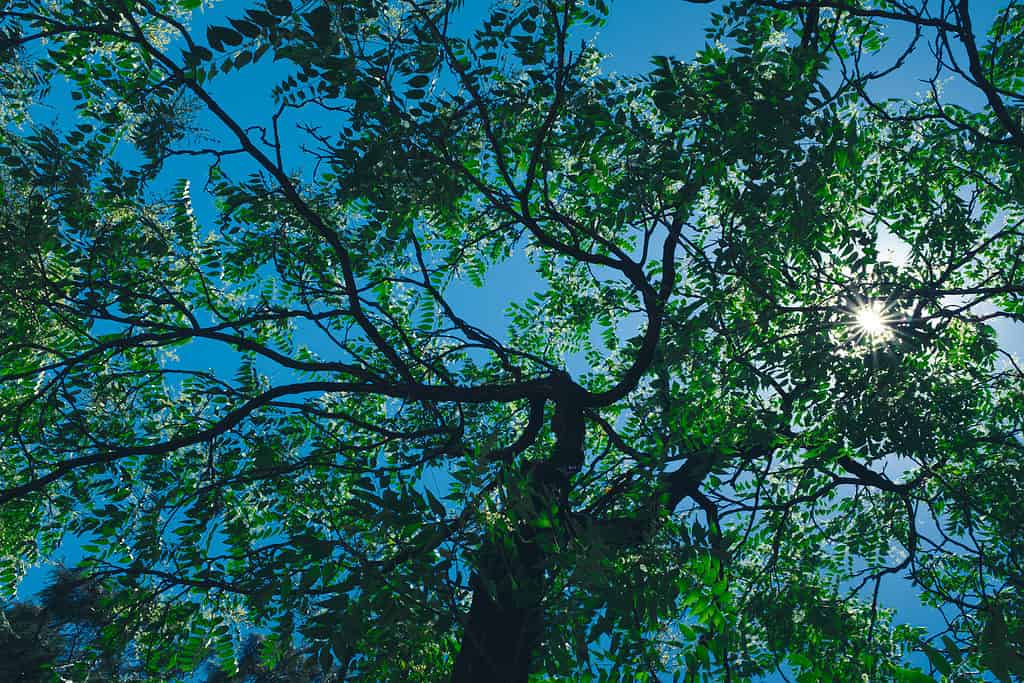
Black locust trees grow throughout the continental United States.
©iStock.com/Ye Zhang
There are also reports of skin punctures from the tree’s thorns. These punctures allow the tree’s toxins to enter the bloodstream, leading to skin rash and swelling. In very rare cases, it has even caused neurologic symptoms and local tissue death (necrosis).
Castor Bean (Ricinus communis)
The castor bean is a woody shrub that many consider a small tree. Its original native range was confined to tropical East Africa, but it has since been cultivated in many parts of the world, including the United States.
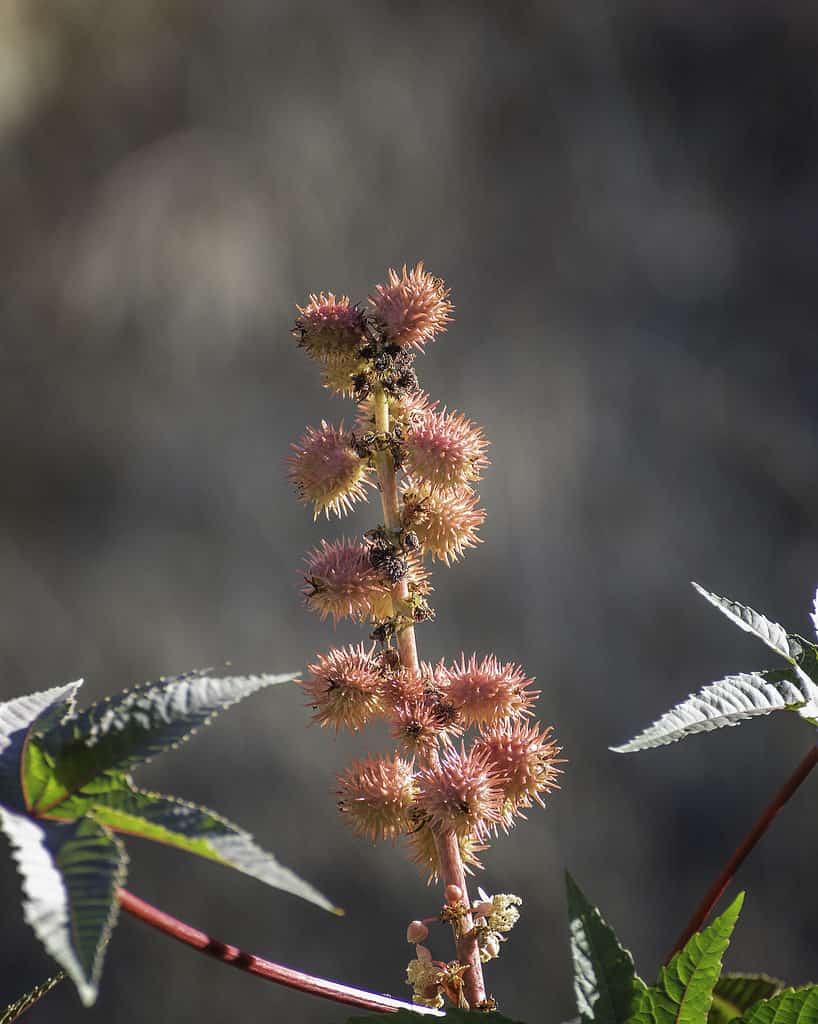
The castor bean features spiny red flowers.
©iStock.com/GDMatt66
The first records of castor beans in the U.S. are from the mid-1800s. Castor beans have been grown for a multitude of uses. In antiquity, the oil from the castor bean was used as fuel for lamps. In the modern era, oil has been used in paints and varnishes, motor oils, inks, soap, and plastics.
There is also a whole generation of Americans who can tell stories of being forced to swallow castor oil as a medicine when they were children. Some of the castor bean’s purported medicinal properties have been debunked, though others have certainly been confirmed.
A Problem Tree
Nevertheless, whatever positives this small tree brought to the U.S., it also brought more than its fair share of problems. This tree that was endemic to East Africa is now widespread across the southern United States. It is classified as an invasive species in many regions.
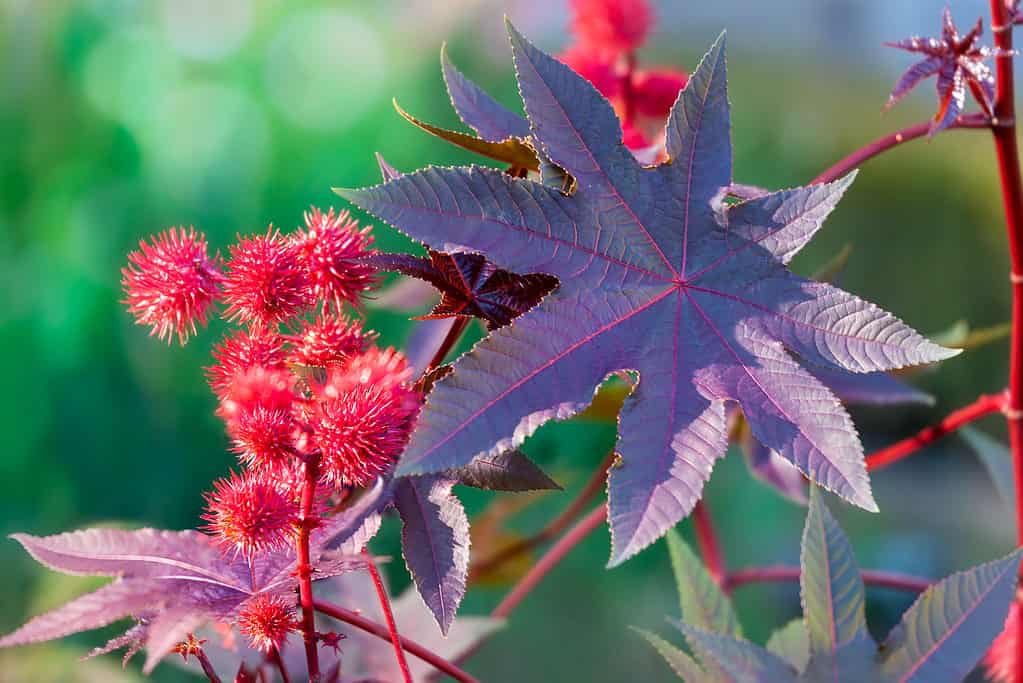
The castor bean features lovely fall colors, but keep your distance!
©iStock.com/TatianaMironenko
The castor bean tree (or shrub) can grow to 15 feet tall on average, though some individual trees have been recorded at nearly 40 feet tall. The tree features thick star-shaped leaves that can grow up to 30 inches across. Those leaves choke off native plants by blocking needed sunlight from reaching them. Large, monospecific stands of castor beans can displace enormous swaths of native vegetation.
Not only is the tree invasive, but it is also toxic. Castor leaves and seeds contain ricin, one of the most lethal poisons found in nature. It is estimated to be 6,000 times more poisonous than cyanide, and 12,000 times more poisonous than the venom of a rattlesnake.
Just four castor seeds are enough to kill an average adult. It is also deadly to animals, and even insects. Castor beans often grow near streams and rivers. The high concentration of ricin can poison insects, such as beetles, ants, and flies. These insects then fall into the water and are eaten by fish and aquatic animals. Thus, ricin perpetuates through the stream and river ecosystem.
Nature’s Surprises
We need trees. Life wouldn’t exist without them. But there are always surprises in the natural world, even among things as essential and seemingly innocuous as trees. These five trees prove that nature always has a few tricks up its sleeve.
Summary of the Five Most Dangerous Trees in the U.S.
Here is a list of the most dangerous trees in the United States:
| Rank | Tree |
|---|---|
| 1 | Manchineel Tree |
| 2 | Sandbox Tree |
| 3 | Eastern Cottonwood |
| 4 | Black Locust Tree |
| 5 | Castor Bean |
The photo featured at the top of this post is © iStock.com/NajaShots
Thank you for reading! Have some feedback for us? Contact the AZ Animals editorial team.






